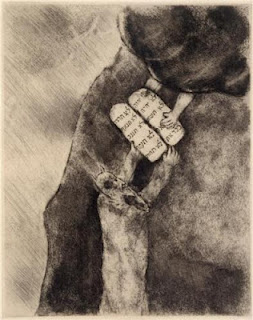 |
| Moses receives the Law on Mount Sinai -- Marc Chagall (1934) |
That strange New Testament episode known as ‘The
Transfiguration’ is unique in our Calendar. It is the only event in the life of
Christ that we observe twice – on the traditional ‘Feast of the Transfiguration’
(Aug 6th) and on the Sunday before Lent, now widely referred to as ‘Transfiguration
Sunday’. The lessons for this year are unusually integrated. The Old Testament
tells the story of Moses on Sinai that Paul then refers to in the Epistle. It
is the very same story that occurs immediately to the disciples, when they see
what happens to Jesus on the mountain top.
 |
| The Transfiguration -- Duccio (1310) |
It was on Mount Sinai that Moses received the Ten
Commandments from God. When he descends his face is shining with a brightness so
unnatural that it unnerves the Israelites. And so, after subsequent visits to
the Holy of Holies, he covers his face with a veil. The message, Paul tells us,
is that the Israelites were unprepared or unwilling to encounter God’s glory.
Now, thanks to Christ, we are enabled to do so. But our ability to do so does
not arise from the Transfiguration that Peter, James and John witness. Rather,
that experience prepares them to witness the Resurrection. It removes the veil
that would otherwise prevent them from seeing God in a crucified criminal.
The season of Lent just approaching is our opportunity to
put aside the various ‘veils’ of selfishness and sin that can hide Easter. Few
of us can expect to have ‘mountain top’ experiences, of course. Yet something
much less dramatic can serve the same end. In his hymn ‘Spirit of God, descend
upon my heart’ the 19thC Irish Anglican priest George Croly (1780-1860) beautifully encapsulated
this thought.
I ask no dream, no prophet ecstasies,
No sudden rending of the veil of clay
No angel visitant, no opening skies.
But take the dimness of my soul away
No comments:
Post a Comment